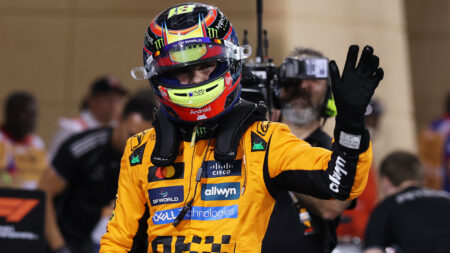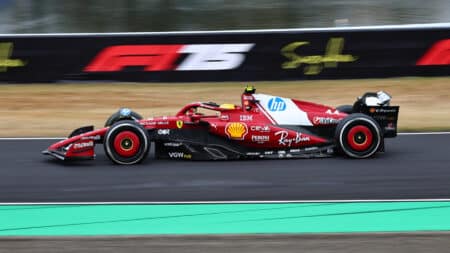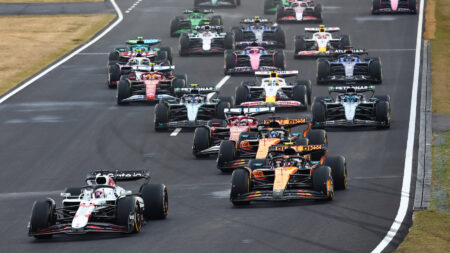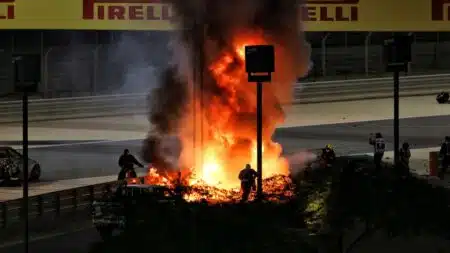
Tomorrow's F1 starting grid for the 2025 Bahrain Grand Prix
Oscar Piastri will be at the front of starting grid for the 2025 Bahrain Grand Prix after a dominant qualifying performance, that left him 0.4sec and five places ahead of…
Le Mans ’66 tells the story of Ford vs Ferrari but it’s already clear from the reviews that a lack of authenticity will irritate racing fans, says Andrew Frankel
Christian Bale and Matt Damon in Le Mans ’66
If there is one genre of film I dislike more than any other, more than musicals, westerns or preposterous adventures in outer space, it’s films about racing. This is not because I have no interest in racing: quite the reverse, it is because I am obsessed by racing that I am effectively impossible to please.
I mention this now because in just over a fortnight a film variously called ‘Ford vs Ferrari’ or ‘Le Mans ‘66’, depending on where you’re watching it, will be released and I’m already bridling at the prospect. This is, of course, completely unfair.
But it only took one read of Damon Cogman’s review in the latest issue of Motor Sport Magazine and the part where he describes a driver changing gear halfway down Mulsanne in order to be able to overtake a rival for those telltale bubbles to start appearing in my blood. It’s like those scenes in other movies we all seen where a driver, pushed beyond to bounds of human endurance in his battle with the enemy decides to push the accelerator as far as it will go. Just imagine that!
I turn into a different person when I watch these films, someone I don’t much like: a person who goes looking for flaws and derives some kind of perverse pleasure in finding them. In the Hunt-Lauda flick ‘Rush’ I found myself nudging my wife and saying ‘I don’t remember Cadwell Park being on the 1976 Grand Prix calendar’ and receiving a well-aimed and entirely deserved elbow in the ribs.
And don’t get me started on Downton Abbey where a race at ‘Brooklands’ alternated from one sequence to the next between dog-slow tracking shots at Goodwood and a former military test track outside Chobham. Serves me right for watching Downton Abbey, I guess.
I’ve even managed to find a reason to loathe the Steve McQueen ‘Le Mans’ movie, a film I’d always held up to be the best of all racing movies, a point proven in part at least by its catastrophic failure at the box office. This was a film for me, featuring proper cars being driven by proper drivers at proper speed around a proper track. But the more I found out about Steve McQueen the person, the less I wanted to watch any film in which he starred. Even it also contained Porsche 917s.
Which means the only racing film I really enjoy watching repeatedly is John Frankenheimer’s ‘Grand Prix’. Yes, the flaws are there – Formula Juniors made up to look like F1 cars and so on – but I find myself able to look past them. It is more imaginatively shot than the McQueen movie, has some approximation of a plot (yes, it matters, even with racing movies) and gives you a racer’s eye view of some of the world’s great tracks, and not just the one presented in Le Mans.
Like McQueen, Frankenheimer shot footage from a car in an actual race, Phil Hill coming out of F1 retirement to drive a McLaren M2B for the first lap of the 1966 Belgian Grand Prix, which just happened to be one of the most eventful in F1 history with literally half the field crashing out in a sudden rainstorm. The scene of Jo Bonnier’s Cooper hanging more than halfway over a precipice, saved only by the excess weight of its Maserati V12 motor has an extra dimension because we know it is real.
James Garner filming at Monaco in 1966 Photo: Motorsport Images
I once spent a day at Monza with its star, James Garner, and a more modest, self-effacing, hopelessly smitten racing enthusiast you could never hope to meet. It was the 30th anniversary of the film’s 1967 release and some of the old cars had been gathered there for a photoshoot. Garner’s insurers had told his minders that he must not drive, first because his arteries weren’t what they were and second because he was, well, James Garner. But even minders have to go for lunch and that was all it took. The sight of Garner essentially nicking a single-seat racing car for a lap of Monza is one I’ll not forget.
And it was Garner who told me about Frankenheimer’s obsession with accuracy. Actually the director and his star didn’t get on too well – indeed Frankenheimer told Garner he wished he’d killed him off early in the film – but no one could doubt his commitment to producing an authentic product, least of all James Garner who not only did all his own driving but also doubled for other cast members unable to handle a racing car.
So if they could do it in 1967, why not today? Or is it simply that no-one cares enough to try?
Ford vs Ferrari: we go behind the scenes on Hollywood’s racing film of the decade in the December issue of Motor Sport Magazine.

Oscar Piastri will be at the front of starting grid for the 2025 Bahrain Grand Prix after a dominant qualifying performance, that left him 0.4sec and five places ahead of…

Ferrari is the Formula 1 team bringing the biggest update for its car in the Bahrain Grand Prix

The FIA says engine manufacturers have committed to the planned 2026 rules, with some modifications

Over the years, the Bahrain Grand Prix has offered plenty of on-track - and some off-track - drama. These are the top controversies from the Sakhir event